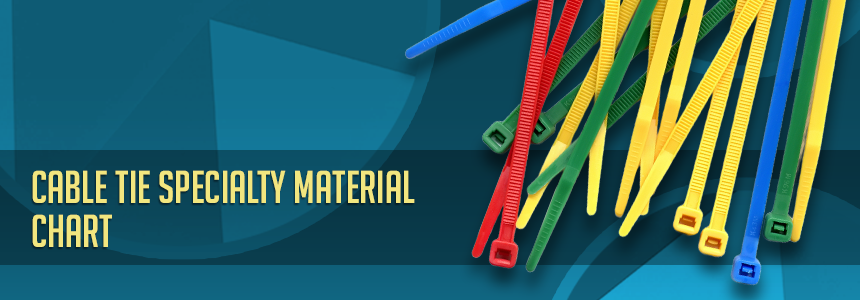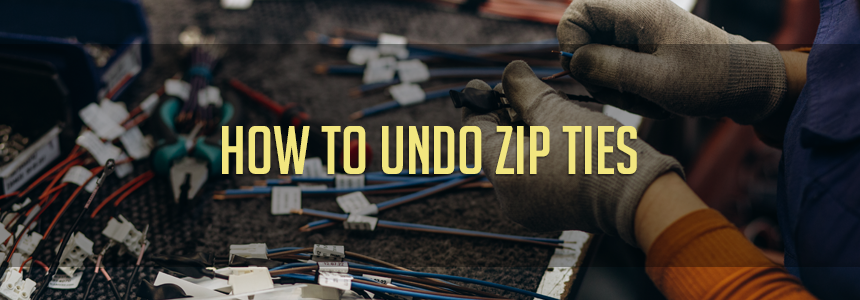Cable Tie Specialty Material Chart

Cable ties are indispensable tools in bundling and securing wires, cables, and other items across various industries, offering a simple yet effective solution for managing and organizing components. From securing wiring on an aircraft to tying down plants in agriculture, the versatility of cable ties is vast. The materials used to manufacture these ties are critical, as they define the tie’s suitability for specific conditions, such as exposure to chemicals, extreme temperatures, and UV light. Different materials enhance the functionality of cable ties, making them suitable for distinct needs: from withstanding the corrosive environment of a chemical plant to enduring the high temperatures near engines or machinery, or providing essential detectability in food processing applications. At Buyheatshrink, we carry a wide range of different specialty material cable ties for every need.
- Tefzel/Fluoropolymer cable ties excel in high-demand environments, such as in the aerospace industry for securing cables subject to intense thermal and chemical exposures, or in the automotive sector where temperature and UV resistance are paramount.
- Polypropylene and UV Black Polypropylene are particularly favored for their buoyancy, making them ideal for maritime applications, and their chemical resistance, which is essential in agricultural settings that involve exposure to various natural elements.
- Nylon 6/6 Extreme Temperature cable ties are chosen for their durability in fluctuating thermal conditions, making them a staple in automotive applications, while their UV resistance benefits long-term outdoor use, such as securing solar panel wiring.
- Fire/Flame Retardant materials are crucial in environments where fire prevention is key, such as in the construction of commercial buildings or in mass transit systems, where they help in managing cables while adhering to fire safety standards.
- PEEK/Polyetheretherketone ties are utilized in high-tech fields, including aerospace and medical industries, for their high-temperature endurance and radiation resistance, while Metal Detectable Polypropylene is indispensable in food production for maintaining health and safety standards.
- Stainless Steel 304/316 zip ties' robustness makes them the material of choice for extreme conditions found in offshore, mining, and heavy industrial applications, as well as for sanitary requirements in the food and pharmaceutical industries.
The selection of the right cable tie material is pivotal, ensuring reliability and safety in the ties' intended application, and the diversity of materials available allows for a tailored approach to cable management across the spectrum of industrial and commercial use.

The table below shows the different types of cable tie materials and a grading of their use in different circumstances.
|
Specialty Material |
Chemical Resistance |
UV Resistance |
High Temperature |
Low Temperature |
Outdoor Exposure |
Metal/X-Ray Detection |
Low Smoke |
Radiation Exposure |
Flame / Fire Rating |
Buoyant |
|---|---|---|---|---|---|---|---|---|---|---|
|
5 |
5 |
5 |
5 |
5 |
NR |
5 |
5 |
5 |
1 |
|
|
Polypropylene |
5 |
2 |
2 |
5 |
1 |
NR |
1 |
5 |
1 |
5 |
|
UV Black Polypropylene |
5 |
5 |
2 |
5 |
5 |
NR |
1 |
5 |
1 |
5 |
|
2 |
5 |
3 |
5 |
3 |
NR |
2 |
1 |
1 |
1 |
|
|
2 |
2 |
2 |
2 |
2 |
NR |
5 |
1 |
5 |
1 |
|
|
5 |
1 |
5 |
2 |
2 |
NR |
5 |
5 |
5 |
1 |
|
|
2 |
1 |
3 |
2 |
3 |
5 |
2 |
1 |
5 |
1 |
|
|
5 |
2 |
2 |
5 |
3 |
5 |
1 |
5 |
1 |
5 |
|
|
2 |
3 |
4 |
2 |
5 |
NR |
5 |
2 |
5 |
1 |
|
|
2 |
5 |
4 |
2 |
5 |
NR |
2 |
1 |
5 |
1 |
|
|
Nylon 12 |
5 |
5 |
3 |
3 |
5 |
NR |
2 |
1 |
2 |
1 |
|
5 |
5 |
5 |
5 |
5 |
5 |
5 |
5 |
5 |
5 |














